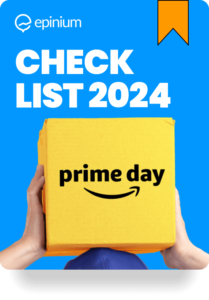In today’s blog post, we will be showing how If designed and run properly, a successful Amazon advertising strategy, it can help you sell more inventory and faster, while also boosting your organic ranking.
The fact that Amazon is growing so fast comes with plenty of opportunities to innovate and make the most of new advertising capabilities. As this trend keeps growing Amazon fine-tunes its offering and its advertising options become more detailed.
From now on, Sellers will have to move quickly to stay updated with new features, formats, and campaign types while always making sure that their current approaches are not getting obsolete. So, businesses who want to go the extra mile will need to have a solid Amazon advertising strategy. This is why we gathered a five-step process for you and your team to fully optimize your Amazon advertising strategy in 2020.
Step 1: Be detail-oriented with goals
From now on, companies that view sales as their unique goal, will no longer have any competitive advantage in the market. In fact, there exist many ways that you can and must adopt on a product, group, or brand level. Some of them could be:
- Be the best on a particular keyword
- Promote the bestseller for a new product line
- Sell-out product
- Gain market share over a competitor
- Stay market leader of a product line
Your ad strategy cannot be a solution to everything. It should match the goals you have decided to pursue.
The most common way to make decisions on your goals is to base them on the four stages of your sales funnel: Awareness, Interest, Decision, and Action, and then set your ad strategy accordingly. Together with this, you would need to consider, at least, a mix of Sponsored Product, Brand, and Display ads to reach customers along the entire funnel journey.
Step 2: Develop a solid campaign structure
One of the most concurrent strategies companies follow to boost visibility and ROI on Amazon is to find and use the right keywords in the best way. Normally, an account that has been running for a while will be filled with manual campaigns and a mix of brand and non-brand keywords.
However, there is a way to fine-tune campaigns and replace those low-performing keywords for high-performing ones in order to have a solid campaign account structure, which enables you to:
Leverage New Auto Campaigns: When starting your campaigns, auto campaigns are the starting point for your PPC strategy. You need to use them to allow Amazon to generate keywords that you then fine-tune with a strategic manual campaign. This is known as a search term optimization.
Search Term gathering: Try to add new keywords or new negative keywords to match your campaigns to your customers interests.
ASIN Discoverability: Check that your keywords and bids are giving your products the visibility they need.
Negative Keyword Opportunities: Use negative keywords to avoid unwanted spending and boost product rankings.
Step 3: Revisit targeting
By using the new manual targeting capabilities on Amazon, you can fine-tune your PPC campaigns to target categories, brands, and ASINs. Also, you have new ways to fine-tune your automatic campaigns.
There are different strategies to be used:Category Targeting, Brand Targeting, and ASIN Targeting. In order to approach this effectively, you need to check your goals and make sure they are aligned with the targeting strategy you pick.
ASIN Targeting: Product ASIN Targeting has got interesting opportunities for advertisers on Amazon, again with several strategic possibilities available. As an example, you can use ASIN targeting when your products are easily comparable to others but cheaper. This is indeed an effective ,method to follow for ASIN targeting ads.
Category Targeting: The Category Targeting feature allows you to target your product categories on Amazon. This can be very useful for the following product types:
Generic products that do not have very detailed (“long-tail”) keywords to optimize for, as generic keywords are usually relatively expensive.
Brand Targeting: You can also use category refinements to target high traffic brands using Amazon Brand Targeting. You can identify competitor brands that are spending heavily on Sponsored Brands and will have the traffic coming their way as a result. You can then target these brands using the “further category” refinements.
Step 4: Blend offense against defense
You need a clear offensive and defensive strategy in place and a solid understanding of your goals for each. As an example, a good defensive strategy might be bidding against your branded search terms to prevent competitors from targeting your listing. Likewise, you could target your competitor’s brand.
A great way to think of it is to allocate around 40% of your budget to defense. This basically means you’ll be targeting keywords directly linked to your brand. You should then allocate about 40% to pursuing keywords you would like to own, including competitor’s brands. The 20% left can then be kept for keyword gathering or testing.
Ranking campaigns: Amazon advertising also has a double benefit of improve organic rankings on search terms. Sales have a direct influence on a product’s organic ranking. Therefore, the higher the sales generated through PPC ads, the higher and positive is the effect on a product’s organic ranking.
Having metrics like conversion rate instead of ACoS can be an effective way to focus your ad budget on improving organic visibility, hence, overall sales.
Ad display on Amazon is based on relevancy, which is why you should make your organic and ad keywords match. Amazon will only show your PPC campaign ad if it’s relevant to the search term of a customer.Therefore, PPC campaigns can only work if a product listing was first optimized for relevant keywords.
Going Steady: You need to maintain a steady presence when it comes to advertising. Amazon now takes most of the space at the top of the page on the first search results page for paid ads.So, if you are always present, your chances of consistently being there boost. It may generate demand and keep your brand on top of customers mind especially as they tend to buy during all hours of the day and night.
Step 5: Think long-term
As an Amazon Seller or Vendor, Customer Lifetime Value (CLV) is especially important. The value of Amazon to eCommerce and retail more generally has resulted in significant investment in analytics tools by third-party vendors. By pulling transactional data from Amazon MWS and making use of advanced machine learning and AI algorithms, advanced Amazon analytics software can reckon solid CLV estimated based on customer persona and estimated ‘buying journeys’. This estimates the total lifetime value of a customer based on the product they buy hence, giving you a far longer-term picture of the value of making a sale.
The eagerness for more advertising opportunities has already started to be reflected in the types of ads Amazon now makes available. The better your analytics, the more effectively you will be able to exercise these new features.
We hope this post was helpful to you and as usual, if you enjoyed it or have any questions on it, feel free to leave a comment on the comments section below.






